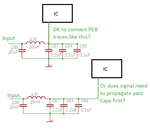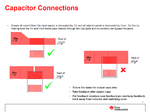matt11
Newbie level 4
When multiple output capacitors are used in an LC filter does it matter where the PCB trace connects to the output of the filter?
Would it matter if the PCB trace was connected between two of the output capacitors or should it be connected at the last capacitor in the chain? (See attached Figure)
I realize that ideally it would not matter, I'm just wondering if the signal needs to actually propagate past all filter components before being applied to additional parts of the design?
Would it matter if the PCB trace was connected between two of the output capacitors or should it be connected at the last capacitor in the chain? (See attached Figure)
I realize that ideally it would not matter, I'm just wondering if the signal needs to actually propagate past all filter components before being applied to additional parts of the design?

